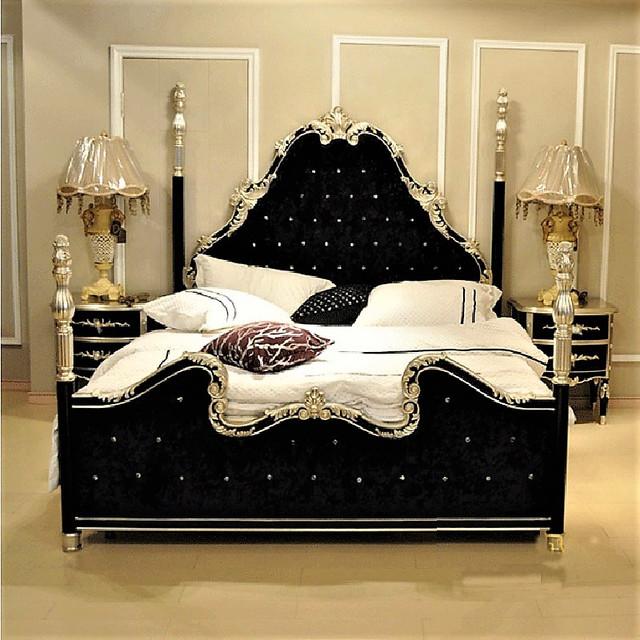The world of interior design is a captivating realm where Baroque furniture and white furniture stand as timeless symbols of sophistication and elegance. Each style holds a distinct allure, exuding its unique charm that transcends time and trends. Let’s delve into the intricate details and rich histories of these two remarkable furniture styles, exploring their characteristics, influences, and enduring popularity in contemporary design.
Baroque Furniture: Ornate Grandeur and Opulence
Baroque furniture traces its origins back to the 17th century in Europe, particularly flourishing in countries like Italy, France, and Spain. This opulent style emerged during a period marked by artistic and cultural exuberance, characterized by a departure from the austerity of the preceding Renaissance era. Embracing extravagant ornamentation and lavish details, Baroque furniture epitomizes grandeur and drama.
The hallmark of Baroque furniture lies in its elaborate designs and intricate embellishments. Ornate carvings, scrolls, gilding, and curved silhouettes define these pieces, showcasing a mastery of craftsmanship. Cabriole legs, exaggerated curves, and motifs inspired by nature, such as floral patterns and cherubic figures, adorn chairs, tables, cabinets, and bed frames, evoking a sense of luxury and nobility.
Materials like richly stained woods, including mahogany and walnut, were commonly used in crafting Baroque furniture, enhancing the pieces’ grandiose appearance. Luxurious fabrics like velvet and silk in vibrant hues complemented the ornate frames, adding to the overall lavishness.
The enduring appeal of Baroque furniture lies in its ability to transform any space into a regal and majestic setting. While traditional Baroque furniture pieces maintain their allure, contemporary adaptations infuse modern elements, creating a fusion of classic opulence and present-day sophistication.
White Furniture: Timeless Simplicity and Versatility
In stark contrast to the ornate extravagance of Baroque furniture, white furniture embodies a sense of simplicity, purity, and versatility. White has long been revered for its timeless appeal, offering a serene and elegant aesthetic that effortlessly complements various design styles.
White furniture holds a remarkable ability to brighten and open up spaces, creating an illusion of expansiveness. Whether it’s a pristine white sofa, a sleek dining table, or a minimalist bookshelf, these pieces exude a sense of airiness and lightness, making them a popular choice for modern interiors.
The neutrality of white allows for seamless integration into diverse design schemes. It serves as a blank canvas, easily adaptable to different color palettes and decorative elements. Additionally, white furniture acts as an excellent backdrop for showcasing artwork, vibrant accessories, or statement pieces, allowing them to take center stage.
Moreover, white furniture transcends trends, making it a wise long-term investment. Its timeless allure ensures that it remains a stylish choice year after year, effortlessly blending into evolving interior design preferences.
The Intersection of Baroque and White Furniture: Fusion of Elegance
Interestingly, the worlds of Baroque furniture and white furniture intersect in unexpected yet harmonious ways. While their aesthetics diverge vastly, incorporating elements from both styles can yield intriguing and stunning results.
Imagine a room adorned with a resplendent Baroque-style ornate mirror against a backdrop of pristine white walls. The juxtaposition creates a captivating contrast, where the ornamental richness of the mirror becomes the focal point in an otherwise minimalist space, showcasing the beauty of blending these two design worlds.
Similarly, integrating a few carefully chosen Baroque furniture pieces, such as a lavishly carved armchair or an intricately designed console table, into an interior predominantly furnished in white can infuse a sense of drama and opulence without overwhelming the space.
Conclusion
In the realm of interior design, both Baroque furniture and white furniture hold distinct places, each offering a unique aesthetic and ambiance. Baroque furniture captivates with its opulent extravagance and intricate detailing, while white furniture entices with its timeless simplicity and adaptability.
Whether you seek the regal allure of Baroque furniture or the serene elegance of white furniture, both styles possess an enduring charm that transcends passing trends. Ultimately, the beauty lies in the eye of the beholder, and the fusion of these styles opens up a world of possibilities, allowing for creative expression and the creation of spaces that exude sophistication and grace.



